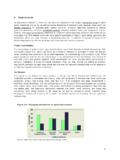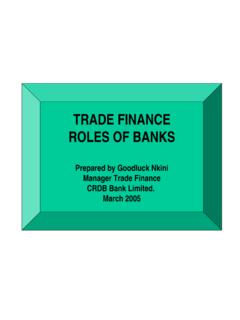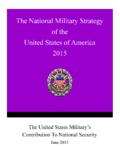Transcription of United Nations Practical Manual on Transfer Pricing
1 United Nations Practical Manual on Transfer Pricing for Developing CountriesUnited Nations Practical Manual on Transfer Pricing for Developing CountriesasdfUnited Nations New York, 2013 Department of Economic & Social AffairsUnited NationsPractical Manual on Transfer Pricingfor Developing CountriesST/ESA/347iiiForewordPRACTICAL Manual ON Transfer Pricing FOR DEVELOPING COUNTRIESThe United Nations Practical Manual on Transfer Pricing for Developing Countries is a response to the need, often expressed by developing countries, for clearer guidance on the policy and admin-istrative aspects of applying Transfer Pricing analysis to some of the transactions of multinational enterprises (MNEs) in particular. Such guidance should not only assist policy makers and administrators in dealing with complex Transfer Pricing issues, but should also assist taxpayers in their dealings with tax United Nations Model Double Taxation Convention between Developed and Developing Countries1 considers (at Article 9 Associated Enterprises ) whether conditions in com-mercial and financial relations between related enterprises, such as two parts of a multinational group, differ from those which would be made between independent enterprises.
2 The same test is applied at Article 9 of the Organisation for Economic Co-operation and Development (OECD) Model Tax Convention on Income and on In this respect both Models, which between them are the basis for nearly all bilateral treaties for avoiding double taxation, endorse the arm s length standard (essentially an approximation of market-based Pricing ) for Pricing of transactions within MNEs. While it is for each country to choose its tax system, this Manual is addressed at countries seeking to apply the arm s length standard to Transfer Pricing issues. This is the approach which nearly every country seeking to address such issues has decided to take. Such an approach minimizes double taxation disputes with other countries, with their potential impact on how a country s investment climate is viewed, while combating potential profit-shifting between jurisdictions where an MNE Nations , Model Double Taxation Convention between Devel-oped and Developing Countries , updated 2011.
3 Available from , Model Tax Convention on Income and Capital .ivUnited Nations Practical Manual on Transfer PricingIn recognizing the Practical reality of the widespread support for, and reliance on, the arm s length standard among both developing and developed countries, the drafters of the Manual have not found it nec-essary, or helpful, for it to take a position on wider debates about other possible standards. The Manual will, at most, help inform such debates at the Practical level, and encourage developing country inputs into debates of great importance to all countries and is a risk, without an effective response to Transfer Pricing issues, that profits might appear to be earned in low- or no-tax jurisdictions (thereby serving to reduce tax rates on taxable profits/incomes and associated tax obligations), and losses might appear to be incurred in high-tax jurisdictions (thereby increasing allowable deductions for tax purposes).
4 This may have the net effect of minimizing taxes and, in so doing, may impact on the legitimate tax revenues of countries where economic activity of the MNE takes place, and therefore the ability of such countries to finance the purposes of this Manual , the term mis- Pricing is used to refer in a short form to Pricing that is not in accordance with the arm s length standard. It is not intended to imply that a tax avoidance or eva-sion motive necessarily exists in a particular case. From the country development perspective, the impact of non-arm s length Pricing does not depend on whether or not such an intention exists, though that may of course affect how countries respond to particular instances of such are as yet no figures which clearly indicate the amount of rev-enue lost to Transfer mis- Pricing that might otherwise be directed to development.
5 However, with intra-firm trade generally regarded as comprising more than 30 per cent of global trade,3 there is reason to 3 See for example Alexander Yeats, Just How Big Is Global Production Sharing? , in Fragmentation: New Production Pattern in the World Econo-my, Sven Arndt and Henryk Kierzkowski, eds. (Oxford, Oxford University Press, 2001); Alfonso Irarrazabal, Andreas Moxnes and Luca David Opro-molla, The Margins of Multinational Production and the Role of Intra-Firm Trade , Journal of Political Economy, vol. 121, (February 2013) and Peter Egger and Tobias Seidel, Corporate taxes and intra-firm trade , July 2010. Available from The share vForewordbelieve that the figures are large. While more research still needs to be done on the size of the potential losses for developing countries, and the situation will no doubt vary greatly from country to country, there is clearly great scope for Pricing decisions about intra-group transac-tions that detrimentally impact domestic revenues for development.
6 Conversely, in this complex area, there is a risk that taxpayers, espe-cially MNEs, will be faced with a multiplicity of approaches to apply-ing the arm s length standard in practice that can lead to compliance burdens and the risk of unrelieved double taxation. This can be the case even where there is no issue of tax avoidance or evasion, because of the scope for differences of view about what the arm s length price would be in a particular case. Helping achieve common understand-ings on Transfer Pricing issues can also improve trust between taxpay-ers and tax authorities, both avoiding some differences between them and helping resolve others more offering Practical guidance to policy makers and administrators on the application of the arm s length principle, the Manual does not seek to be prescriptive. In particular it recognizes that the needs of coun-tries, along with their capabilities, will evolve over time.
7 A phased or life cycle approach, with a Transfer Pricing capability strategy identi-fying short, medium and longer term objectives and areas of focus will therefore often yield the best results. It follows that many developing countries may find the early history of Transfer Pricing in developed countries to be of special relevance, as well as the current practices in other, especially developing, showing ways in which the arm s length approach to Transfer Pricing can operate effectively for developing countries, while giving a fair and predictable result to those investing in such countries, the Manual will also help explain why that approach has been found so of intra-firm trade is however, very difficult to measure, varies significantly between countries and depends on the definition of relevant relationships.
8 See for example Rainer Lanz and S bastien Miroudot, Intra-Firm Trade: Patterns, Determinants and Policy Implications , OECD Trade Policy Work-ing Papers, No. 114, (Paris, OECD, 2011). Available from (2010)27/FINAL&docLanguage=En at page 12 Nations Practical Manual on Transfer Pricingbroadly acceptable, including in both major Model Tax Conventions. It should therefore assist countries in important decisions on how to address Transfer Pricing issues, whatever approach they ultimately take. It will also play a part in signposting areas where more support and assistance may be needed for countries at the various stages of their Transfer Pricing journeys . An approach to risk management will need to inform Transfer Pricing strategies, recognizing the areas of greatest mis- Pricing risk, and the benefits of tax administrations constructively engaging with taxpay-ers to help them to know and meet their responsibilities.
9 Resource-effective ways of addressing those risks from the points of view of both government and taxpayers will be of particular importance for devel-oping country tax administrations. There are a number of other guiding principles that have informed this Manual and reflect the mandate of the Subcommittee involved in its drafting, including that: This is a Practical Manual rather than a legislative model; The drafting should be as simple and clear as the subject matter permits; The Manual will be prepared initially in English, but with a recognition that this will not be the first language of most users. It should be translated at least into the other official United Nations languages; A key value added of the Manual is to be its Practical -ity addressing real issues for developing countries (and of course those dealing with the administrations of such countries) in a Practical and problem-solving way.
10 It there-fore seeks to address the theory of Transfer Pricing , but in a way that reflects developing country realities in this area; The Manual , as a product of the United Nations Committee of Experts on International Cooperation in Tax Matters, has a special role in reflecting the diversity of the United Nations Membership and placing Transfer Pricing in its developmental perspective. This recognizes both the importance to development of fair and effective tax systems, but also the fact that foreign investment, on appropriate viiForewordterms, is seen as an important path to development by most countries; Helpful guidance in this complex area must, in particular, be geared to the inevitable limitations in some countries administrations, and deficits in information and skills that many countries are affected by in this area.














